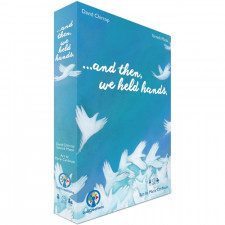... and then, we held hands. Review
on Mar 8, 2016
Limiting player communication in co-op games is a thematic challenge, and even award-winning games like Hanabi and Pandemic use limited communication to enhance gameplay often at the cost of believability. Not every gamer is concerned about theme, but for me it’s the only reason to play games. Ludi Creations discovered a great, thematic way to include limited communication in their 2015 release, which I’m not going to retype here because it plays havoc with Word’s grammar check.
Two players use cards, tokens and every means of communication they can think of that doesn’t directly involve the game to move around on an abstract board full of emotions, striving to arrive at the calm center simultaneously once all emotional hurdles are overcome. The six starting cards laid out in front of each player feature beautifully-illustrated emotions made up of two primal feelings, with the player’s emotional state determining which side of the cards are visible, an interesting mechanic that shifts the team’s options several times mid-game while keeping with the overall theme of emotional mastery.
Depending on cards used, a player’s emotional state can also vary between intense joy and anger, limiting their available responses to each challenge, and only by bringing themselves back to a stable center can they acquire more cards and increase their team’s options for surmounting future challenges. The team must draw on one another to get through this expressive minefield, realizing which player’s better equipped to deal with the current crisis and which player needs to find their center and reload their emotional cards to prepare for the future, all without verbal coercion, and mastering this level of teamwork brings a satisfaction all its own, whether the game is won or lost.
Early contests involve frowns, raised eyebrows and quick losses. The game comes across as nothing more than abstract color-matching and you both wonder how you can solve its twenty-four objectives when you burned through your cards by the fifth one, but after a few plays, the web of colored dots (with symbols included in a thoughtful nod to color-blind gamers) coalesces into the designers’ goal: a navigable pattern of conflicts overcome through sacrifice, economy of movement and carefully laid nonverbal hints, and when your partner picks up on those hints, it’s more satisfying than the most optimized economic engine in Victorian Europe.
Even the best couple can be subject to what feels like the whimsy of fate, and the game’s objective cards can conspire to ruin their best intentions, presenting a succession of objectives that require too many player cards to overcome, or ruining their draw with a block of useless emotions. While sustained blasts of expressive randomness affect all relationships to a degree, repeated doses of the gaming variety can lead to outbreaks of the real thing, since the real-world goal is fun, and the card decks in this game can sometimes derail a pleasant evening’s plans with a sequence of feelings that the team can’t resolve, and while it can come off as odd to lose a game due to excessive happiness, well, them’s the rules.
A difficulty upgrade is offered in the form of Arguments, gray bars on the sides of some objective cards that can only be overcome if both players land on the exact same spot in succession. This breaks a game rule, but also introduces a very challenging game mode, since players start on opposite sides of the board from each other and must play a card to move each space. Billed as a feature for gamers wanting more of a challenge, it isn’t kidding; the Argument variant ramps difficulty up considerably if those gray-barred cards show up in the first deck, involving the largest, outermost circle, where reaching the same space as your teammate can involve using all six cards in one turn.
…and then, we held hands. (sorry grammar check) gives players the first true thematic limited communication co-op on the market, a challenge that not only satisfies, but actually helps teammates know more about one another, sending them on a true emotional journey. Its short play time and singular game mode make it an ideal filler or occasional entertainment option, and while that means there aren’t layered strategies to uncover after dozens of plays, its mechanic allows players to uncover each other’s mental and emotional layers, which is a rare and inviting thing in today’s hobby world.

 Customer Support
Customer Support  Subscribe
Subscribe 




 Account
Account  Wishlist
Wishlist 

